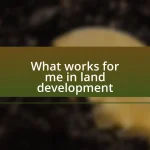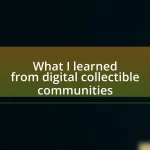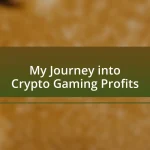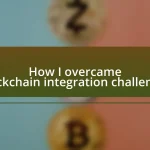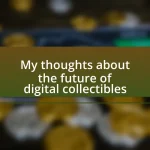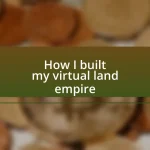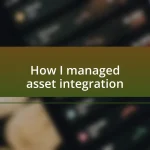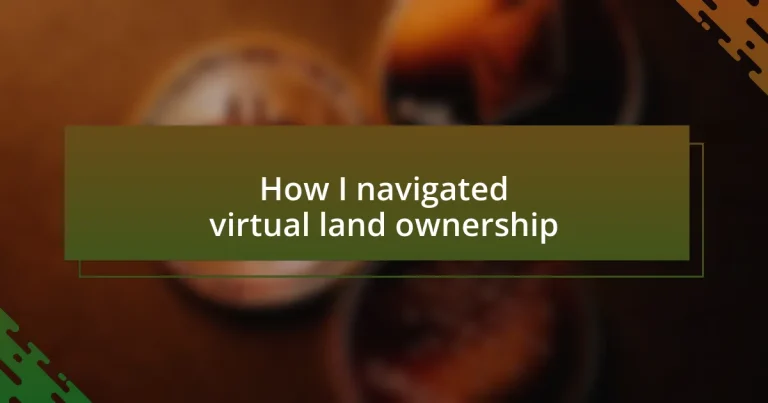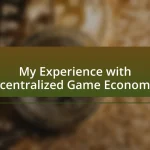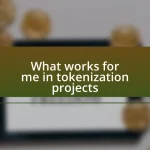Key takeaways:
- Virtual land ownership offers real-world value with potential for creativity and monetization.
- Key factors in assessing virtual land value include location, development potential, and market trends.
- Navigating purchases effectively involves research, community engagement, and understanding transaction costs.
- Monetization strategies include hosting events, leasing space, and selling digital goods to maximize asset value.
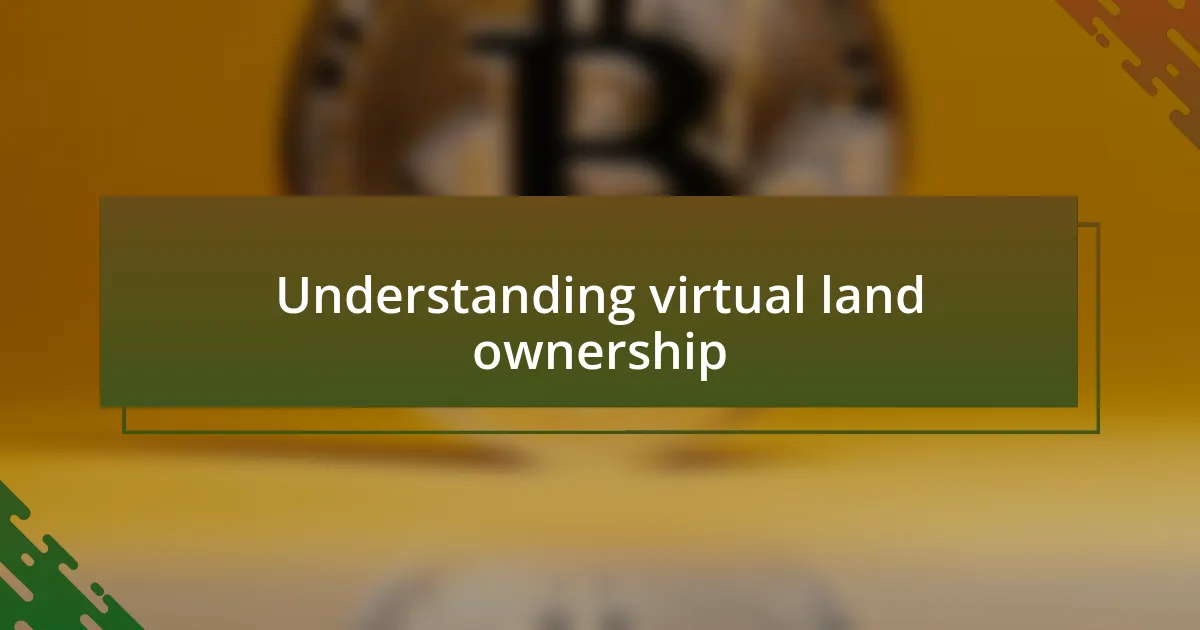
Understanding virtual land ownership
Virtual land ownership is a fascinating concept that blurs the lines between reality and digital existence. I remember the thrill of acquiring my first virtual plot; it felt as if I had just scored a prized piece of treasure in a treasure hunt. Can you imagine the excitement of claiming a space that exists only in the digital realm, yet holds real-world value?
As I delved deeper into this virtual landscape, I started to realize that owning virtual land is not just about the acquisition—it’s about the potential. Picture this: a canvas of endless possibilities where you can create, build, and monetize. How does the idea of owning a piece of a digital world resonate with you? I found myself daydreaming about the projects I could embark on, making my mark in a place where creativity knows no bounds.
Navigating this new territory required understanding various platforms and their unique ecosystems. The emotional rollercoaster of learning about blockchain technology and cryptocurrency was quite an experience! Have you ever felt lost in the sea of information? I certainly did at times, but persevering through that confusion opened doors to a world I never knew existed, and that transformation was empowering.
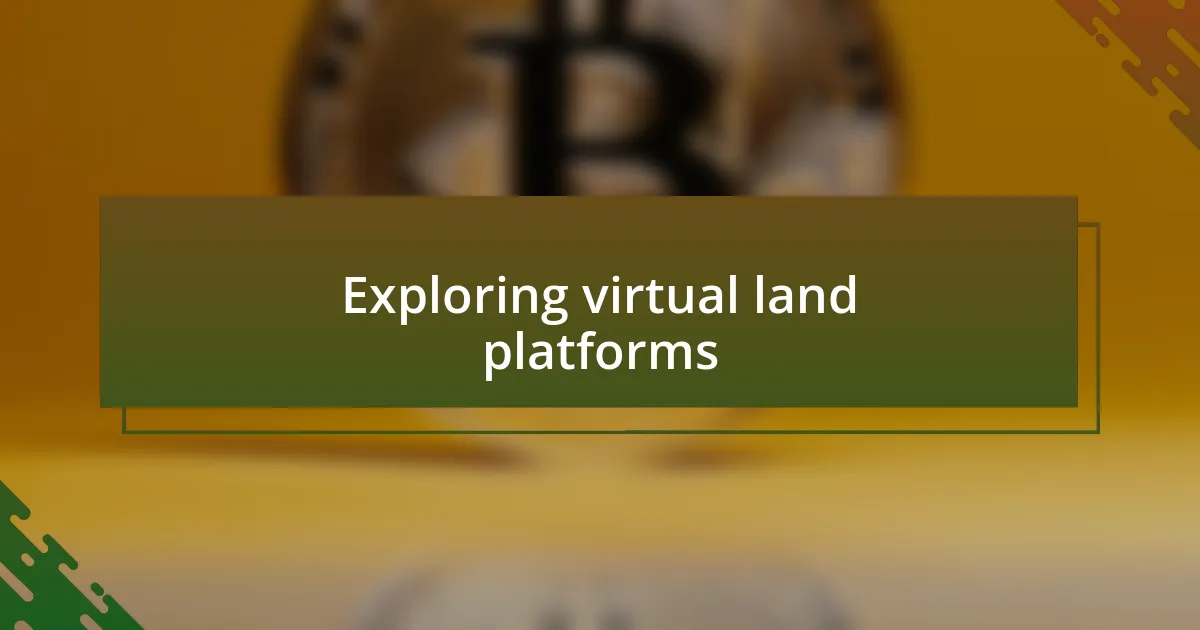
Exploring virtual land platforms
When I first started exploring virtual land platforms, I felt a mix of curiosity and anxiety. Each platform offered a unique landscape—some vibrant and bustling with activity, while others felt more like quiet neighborhoods waiting to be discovered. I often found myself scrolling through different maps, captivated by the creativity on display. It’s a bit like wandering through an art gallery, where each virtual plot tells its own story.
Here are some popular virtual land platforms that I came across:
- Decentraland: A decentralized platform where users can create, experience, and monetize content and applications.
- The Sandbox: A gaming platform that allows users to create, own, and monetize their gaming experiences.
- Cryptovoxels: A virtual world built on the Ethereum blockchain, offering pixelated voxel land for building and customizing.
- Somnium Space: Known for its VR capabilities, it provides a rich environment for interacting and exploring.
- Axie Infinity: While primarily a game, it incorporates land ownership as part of its ecosystem, allowing players to stake and develop their land.
Each discovery was an emotional journey filled with the excitement of potential and the challenge of navigating new technology, and I often questioned which would truly feel like home.
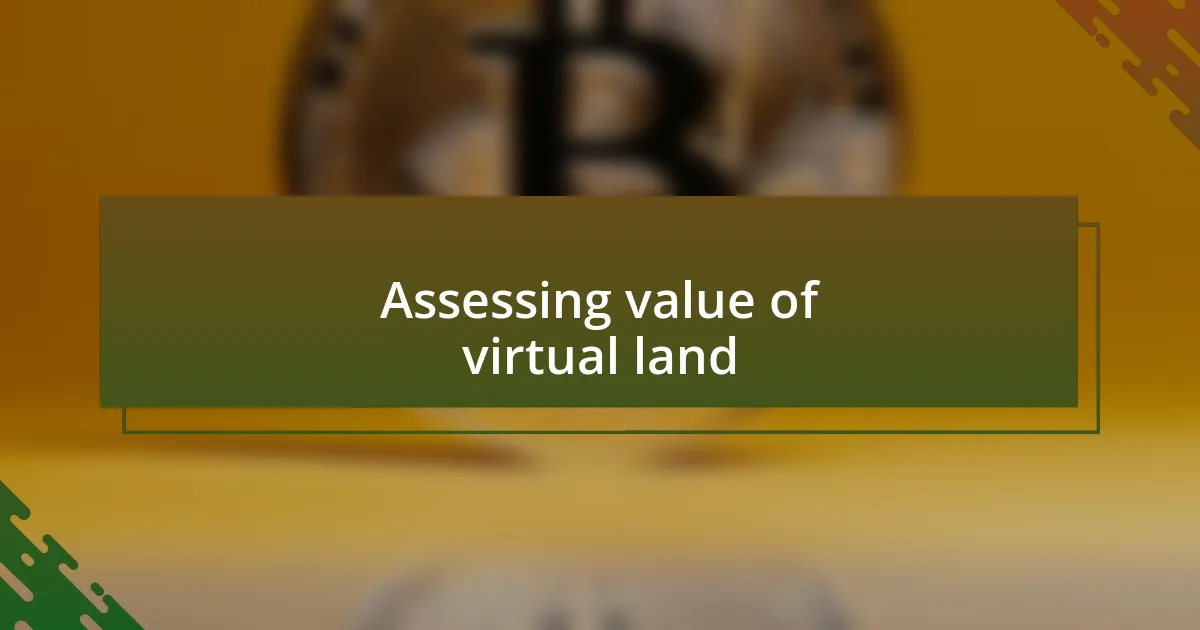
Assessing value of virtual land
Assessing the value of virtual land requires a multi-faceted approach. One of the crucial factors is location within the platform. I remember when I purchased my first plot; I thought I’d found a hidden gem on the outskirts of a popular area. However, I quickly realized that proximity to in-demand zones often dictates not just activity, but also potential future value. Similarly, the uniqueness of the plot can dramatically affect its worth; limited editions or parcels with striking features tend to attract more attention and higher bids.
Another aspect to consider is the development potential of the virtual land. When I later invested in a parcel near a virtual marketplace, I felt a thrill watching how the space transformed. Community events and experiences crafted by landowners can significantly enhance the land’s attractiveness and, therefore, its value. This tells me that active engagement and creativity can yield impressive returns that mere location alone might not provide.
Lastly, the overall market trends within the specific virtual platform play a pivotal role. Just like in the physical property market, trends can shift rapidly in the virtual realm. I often keep an eye on community discussions and market reports to gauge the emerging hotspots and gather insights from seasoned landowners. This research can be the key to making informed decisions that lead to successful investments in virtual landscapes.
| Factor | Description |
|---|---|
| Location | Proximity to popular areas can enhance value significantly. |
| Development Potential | Active engagement and creativity can improve attractiveness and worth. |
| Market Trends | Staying updated on trends helps in making informed investment decisions. |
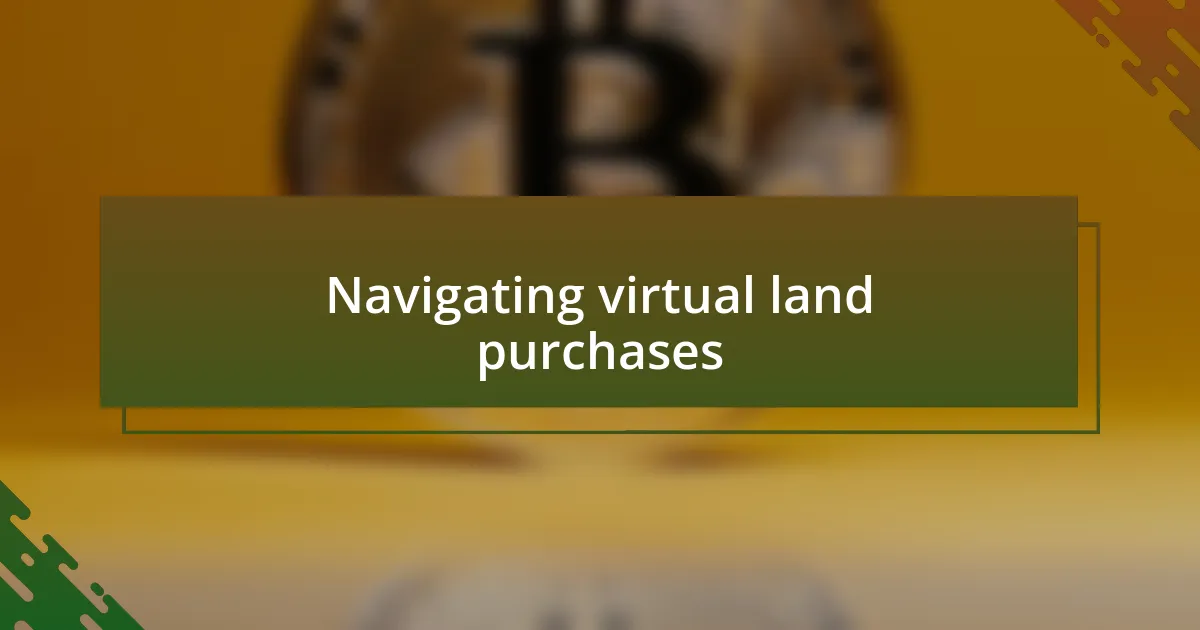
Navigating virtual land purchases
Navigating virtual land purchases can feel overwhelming at first, but I found that breaking it down into manageable steps helped immensely. After researching different platforms, I remember diving into the purchasing process with the same thrill one might feel at a live auction. Choosing the right marketplace is crucial; I learned quickly that not all platforms offer the same level of security or community engagement.
I vividly recall a moment of hesitation before finalizing my first purchase. Was I too early to invest, or was I about to miss out on a golden opportunity? This internal debate kept me up the night before the auction. But I soon realized that leveraging tools like virtual tours and community insights can provide valuable context to the purchase decision. By engaging with other landowners, I gained perspectives that calmed my nerves, making my decisions more informed and less impulsive.
Furthermore, each transaction also comes with its own set of complexities that can be daunting. For instance, I encountered challenges like understanding gas fees, which are transaction costs on blockchain networks. Initially, I found them confusing, but with a bit of research and trial and error, I ensured my budget covered these unforeseen expenses. By equipping myself with knowledge, I was able to navigate these intricacies confidently, turning what once felt like obstacles into stepping stones.
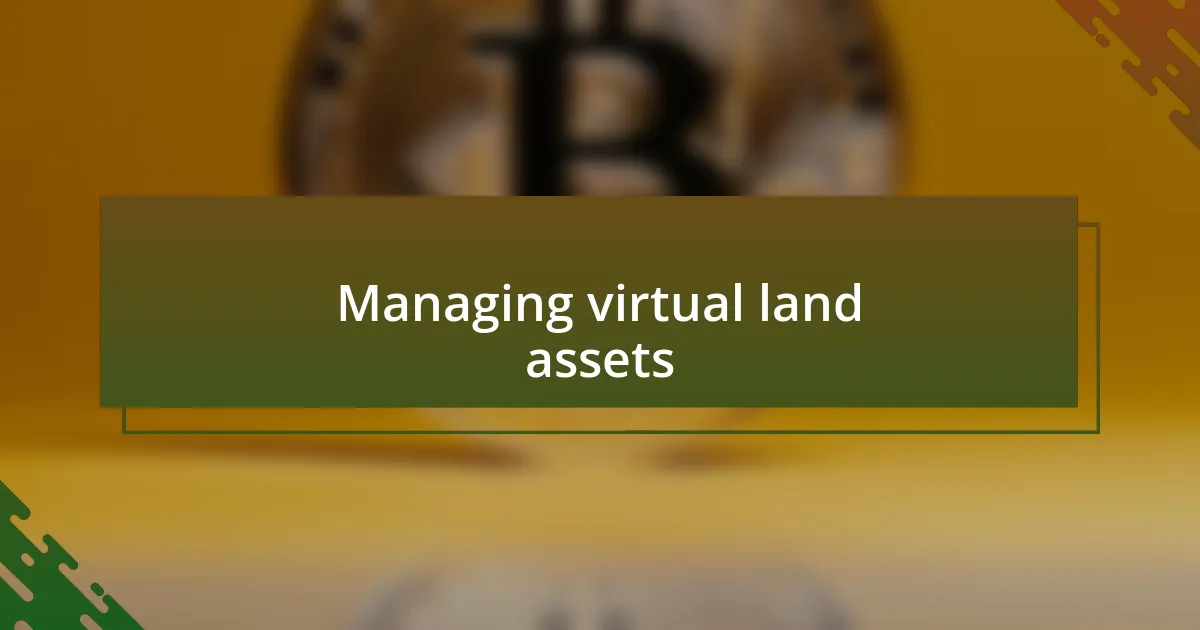
Managing virtual land assets
Managing virtual land assets involves a continuous learning process that can be both rewarding and challenging. I found that regularly monitoring market trends is essential. For example, I remember when the prices for certain virtual plots skyrocketed, and it felt exhilarating yet nerve-wracking. Should I hold on to my assets longer, or was it time to cash in? Staying informed about developments in the virtual real estate landscape allowed me to make strategic decisions, rather than reacting impulsively.
Another vital aspect is engaging with your virtual community. Connecting with other landowners can provide significant insights into the value of your virtual land assets. I recall participating in a forum where someone shared their experience about holding virtual events on their land, which not only increased its worth but also fostered a sense of belonging. Have you considered how engagement can enhance your asset’s attractiveness? I found that building relationships in this space not only offered practical advice but also created a network of support and encouragement.
Furthermore, I learned that diversifying your virtual land portfolio can mitigate risks. When I first began, I focused too much on a single high-value piece. When its value fluctuated unpredictably, I felt a sense of panic. I quickly adapted by spreading my investments across different virtual environments and marketplaces. This strategy not only stabilized my portfolio but also opened up exciting new avenues, allowing me to experiment with creative projects and collaborations.
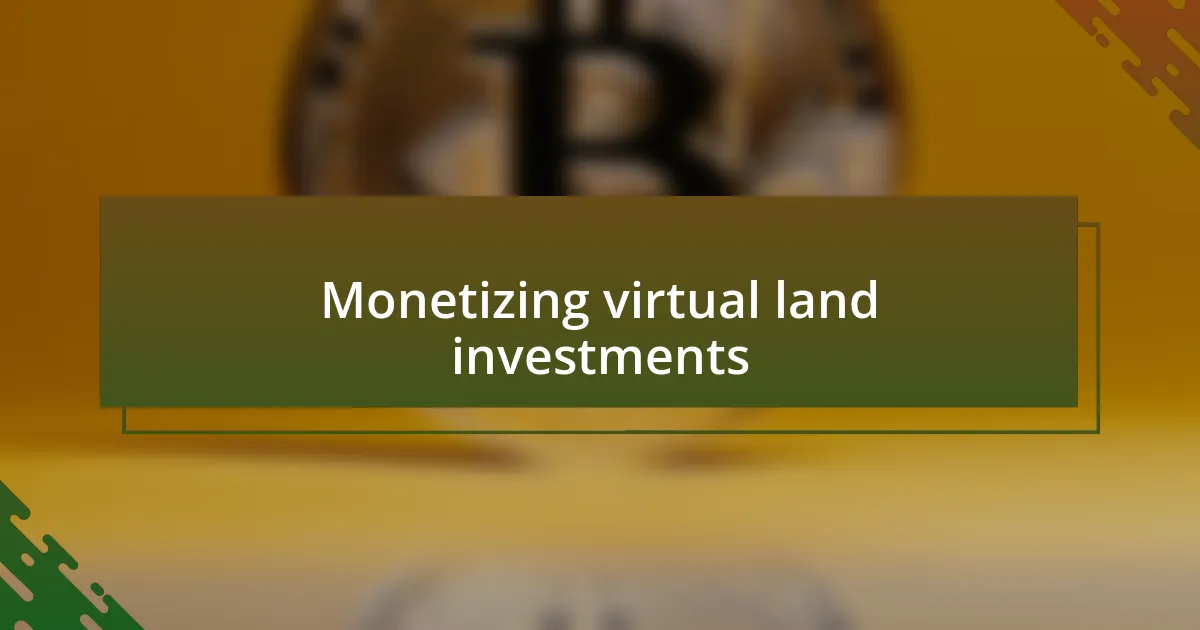
Monetizing virtual land investments
Monetizing virtual land investments can take various forms, each with its unique challenges and rewards. One of the most effective strategies I’ve discovered is hosting virtual events. I remember organizing a small concert on my land; it combined my passion for music with an opportunity to attract visitors. The excitement in the air was palpable, and the ticket sales not only generated income but also increased my land’s visibility and value. Have you ever thought about how creativity can directly impact your finances?
Another avenue I explored was leasing out virtual space to businesses and creators. It sounded daunting at first, but after reaching out to local brands in the community, I was pleasantly surprised by the interest. Securing long-term rentals transformed my land into a consistent revenue stream, providing not just financial stability but also fostering connections with budding entrepreneurs. Could this approach add a layer of security to your investments?
Lastly, participating in the burgeoning marketplace for digital goods has proven invaluable. When I began selling unique digital artworks from my land, it felt exhilarating to unlock new potential sources of income. I had a moment of realization that every virtual plot isn’t just land; it’s a canvas for expression and commerce. How often do we overlook the creative possibilities of our investments? Embracing these opportunities has allowed me to tap into a wealth of profitability while sharing a piece of my vision with the larger community.


